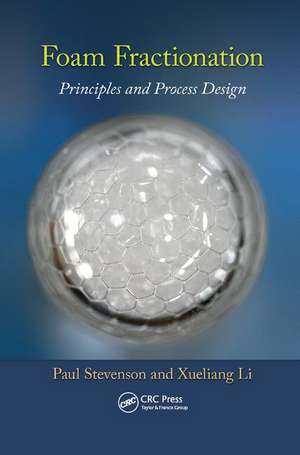Foam Fractionation: Principles and Process Design
Autor Paul Stevenson, Xueliang Lien Limba Engleză Paperback – 22 noi 2017
To assist in the widespread adoption of this highly affordable yet powerful process, Foam Fractionation: Principles and Process Design:
- Provides a systematic explanation of the underlying physics of foam fractionation
- Discusses the fundamentals of molecular adsorption to gas liquid interfaces and the dynamics of foam
- Describes foam fractionation process intensification strategies
- Supplies design guidance for plant-scale installations
- Contains the latest knowledge of foam fractionation transport processes
- Presents a case study of the world’s largest commercial foam fractionation plant producing the food preservative Nisin
Preț: 524.78 lei
Preț vechi: 703.30 lei
-25% Nou
Puncte Express: 787
Preț estimativ în valută:
100.45€ • 109.15$ • 84.43£
100.45€ • 109.15$ • 84.43£
Carte tipărită la comandă
Livrare economică 22 aprilie-06 mai
Preluare comenzi: 021 569.72.76
Specificații
ISBN-13: 9781138074286
ISBN-10: 1138074284
Pagini: 206
Ilustrații: 4 Tables, black and white; 78 Illustrations, black and white
Dimensiuni: 156 x 234 x 17 mm
Greutate: 0.45 kg
Ediția:1
Editura: CRC Press
Colecția CRC Press
ISBN-10: 1138074284
Pagini: 206
Ilustrații: 4 Tables, black and white; 78 Illustrations, black and white
Dimensiuni: 156 x 234 x 17 mm
Greutate: 0.45 kg
Ediția:1
Editura: CRC Press
Colecția CRC Press
Cuprins
Introduction. Adsorption of Surface Active Species to Gas-Liquid Interfaces. Hydrodynamics of Pneumatic Foam. Mechanisms of Foam Instability. Hydrodynamics of Bubble Swarms. Modes of Operation. Bubble Production and Foamate Recovery. Column and Process Design. Process Intensification. Case Study: The Production of Nisin.
Notă biografică
Paul Stevenson undertook four chemical engineering degrees and his post-doctoral training at the University of Cambridge, UK. Currently he is faculty at the University of Hull, a guest professor at the China University of Petroleum, adjunct associate professor in the Reservoir Engineering Group of the University of Western Australia, and chief technical officer at Lower Belford Resources. He previously held academic positions at the Universities of Auckland, New Zealand, and Newcastle, Australia. His research work lies at the nexus of multiphase flow and surface science and involves investigations into enhanced oil recovery, gas-liquid mass transfer and mineral flotation.
Xueliang Li received his master’s degree from Hebei University of Technology, China, where he researched foam fractionation in collaboration with Tianjin Kangyi Biotechnology Co., Ltd. He subsequently worked directly for the company, participating in the design of the only industrial protein foam fractionation units in the world. He commenced doctoral studies at the University of Newcastle, Australia, and then transferred to the University of Auckland, New Zealand, where he worked as a research assistant in the Department of Chemical and Materials Engineering. Upon graduation, he joined Lanzatech NZ Ltd., Auckland, New Zealand and currently leads their bioreactor scaling up effort.
Xueliang Li received his master’s degree from Hebei University of Technology, China, where he researched foam fractionation in collaboration with Tianjin Kangyi Biotechnology Co., Ltd. He subsequently worked directly for the company, participating in the design of the only industrial protein foam fractionation units in the world. He commenced doctoral studies at the University of Newcastle, Australia, and then transferred to the University of Auckland, New Zealand, where he worked as a research assistant in the Department of Chemical and Materials Engineering. Upon graduation, he joined Lanzatech NZ Ltd., Auckland, New Zealand and currently leads their bioreactor scaling up effort.
Recenzii
"This is an excellent, well-written book. It can appeal to a range of readers from those interested in foaming out wastes from fish tanks to those concerned with inexpensively recovering enzymes from dilute industrial and waste solutions. I learned a lot reading the early draft even from the introductory chapter…"
—Robert D. Tanner, Emeritus Professor, Vanderbilt University, Nashville, Tennessee, USA and Visiting Associate, California Institute of Technology, Pasadena, USA
"The authors’ deep appreciation for and extensive knowledge of foam fractionation shines through in their writing. They have written a lucid, approachable, and in-depth account of an important but poorly understood topic."
—Czarena Crofcheck, Associate Professor and Director of Undergraduate Studies, Biosystems and Agricultural Engineering, University of Kentucky, Lexington, USA
—Robert D. Tanner, Emeritus Professor, Vanderbilt University, Nashville, Tennessee, USA and Visiting Associate, California Institute of Technology, Pasadena, USA
"The authors’ deep appreciation for and extensive knowledge of foam fractionation shines through in their writing. They have written a lucid, approachable, and in-depth account of an important but poorly understood topic."
—Czarena Crofcheck, Associate Professor and Director of Undergraduate Studies, Biosystems and Agricultural Engineering, University of Kentucky, Lexington, USA
Descriere
This book explains the underlying physics of foam fractionation, describes process intensification strategies, provides design guidance for plant-scale installations, contains the latest knowledge of foam fractionation transport processes, and presents a case study of the world’s largest commercial foam fractionation plant producing the food preservative Nisin. It capitalizes on the authors’ extensive practical experience of foam fractionation and allied processes to give process engineers, industrial designers, chemical engineers, academics, and graduate students a greater understanding of the mechanistic basis and real-world applications of foam fractionation.
